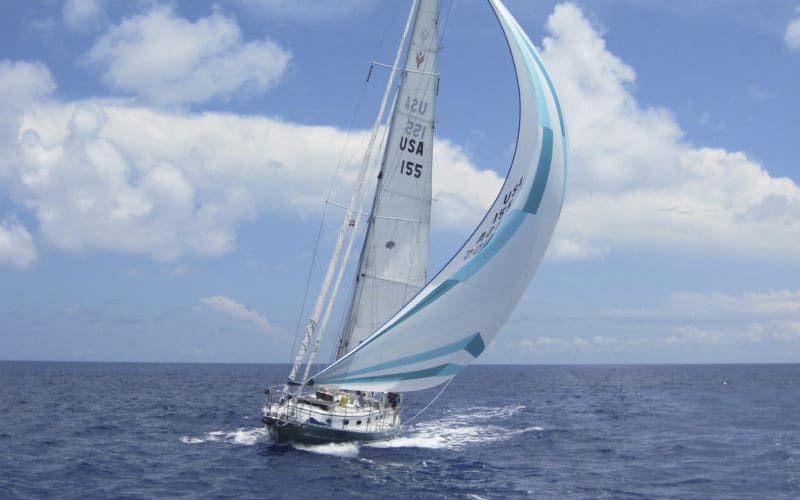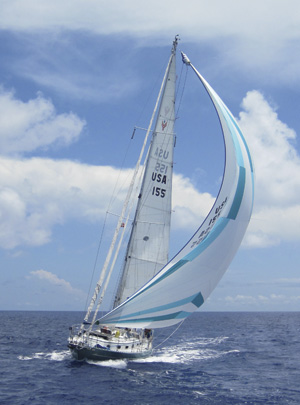 |
|
Above, the Valiant 42 WildHorse at sea flying its asymmetrical spinnaker. Peter Jacob-Dolan |
The sinister amoeba-shaped images on the radar told a stark story — we were about to be hit by several big ones. In a night of many squalls, we had been battered and blown well off course. Our destination, St. Maarten in the Leeward Islands, often was behind us as we battled to stay in control. This was the third successive night of heavy squalls, interrupted only by rainy, blustery days of headwinds. The conditions were physically punishing and psychologically dispiriting.
From the nav station I yelled, “Squall Valley!” to alert the on-watch crew, and yet again we went through the strenuous prep of shortening main, jib and staysail on our Valiant 42, WildHorse. Our progress towards St. Maarten had stopped dead two days before when we reached the eastern-most waypoint of our sailing strategy. Departing from St. George’s, Bermuda, we had elected to sail well east of the rhumb line to avoid a huge cold front charging off the U.S. East Coast. We believed that if we could reach 27° N, 062° W, we would find southeasterlies and be able to close reach our way down to the latitude of 22° N where the easterly trades were a cinch, and we’d have nice, clean ocean sailing.
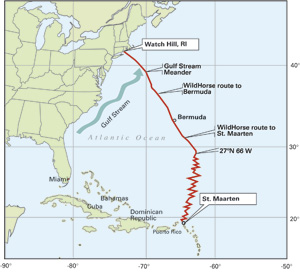 |
|
WildHorse’s passage to St. Maarten was disrupted south of Bermuda by headwinds, forcing Rick Meisner and his crew to make 30 tacks to fetch the Leeward Isles. Alfred Wood/Ocean Navigator illustration |
But it was not to be. All of our keen assumptions proved wrong, reminding me yet again of the message contained in the first three letters of that overused word. True, the big low did not lay a glove on us even though we could see violent weather far to our west. But to commit to our nav strategy to stay east, we had to motorsail in light air for two days, reaching a point some 100 nm east of the rhumb line to St. Maarten. This distance would have to be made up, of course, but presumably under sail and in steady east component air.
Tacking east-west
The situation was now clear: we had expended much energy, time and resources to fetch this mark, only to find it impossible to make southward gains on St. Maarten. Instead of the expected port tack, southerly heading of 205 nm, we could manage only east-west tacks with precious little to show for the effort. Tacking west we had a nice shot at the Dominican Republic, while tacking east we were holding the Canary Islands. Neither were in my nav plan. Our strategy had left us more than 500 nm dead upwind of our destination.
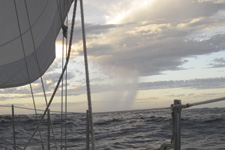 |
|
For much of WildHorse’s trip south of Bermuda, blustery conditions prevailed. |
If this condition had lasted 24 or even 48 hours, it would not have been much of an issue — who hasn’t been headed from time to time? In this case, however, the unrelenting poor and boisterous weather along with virtually no gain on our destination began to have sobering effects on my usually jaunty crew. As for myself, it marked the first time in my offshore sailing career that I was seemingly incapable of fetching a distant destination. I have to admit it is a strange burden, in its own way more sapping of spirit than severe weather or boat system issues.
I had my “Dream Team” as my crew and felt very fortunate, indeed. All captains in their own right, all were close friends and had sailed WildHorse long distances before. Aboard was Charles Drakos, who had just returned from his fourth year of sailing his Hylas 46, Elena, in the Mediterranean. Drakos is tough and resolute, getting better as conditions deteriorate, and brings a wealth of offshore experience and technical savvy. Rick Lueders is everyone’s favorite shipmate — a sharp wit and keen sense of humor that picks up the whole crew. Lueders has sailed thousands of miles on WildHorse, and although sadly touched by mal-de-mer, he bravely keeps coming back for more. Bill McGraw, a bear of a man with immense strength, brings a unique combination of racing, cruising and boat renovation experience. No task aboard a sailboat is too menial or complicated for his enthusiastic nature, and he often devises innovative solutions to the issue at hand.
 |
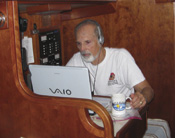 |
|
Above, the radar reveals WildHorse surrounded by squalls. Below, Meisner gathers data via SSB. |
A steadfast crew
With this stellar crew, we had nailed our nav plan for the first leg of our voyage, Watch Hill, R.I. to Bermuda, which we fetched in four and a half days. With weather guru Chris Parker’s help (Marine Weather Center; www.mwxc.com), we slipped out of Bermuda in an early weather window, including careful Gulf Stream waypoints to take advantage of two large eddies — one cold, one warm — on our crossing. Parker had said we would “have weather” in the Stream and he was right. With northwest wind gusting at more than 40 knots, and with huge, steep, short period waves, WildHorse was in her element even if her crew was not. It was a raucous but fast ride, and after our nighttime entry into St. George’s Harbour in Bermuda, we thought we had passed the biggest test of our journey. We were wrong.
“So, on to the next squall,” I thought grimly, “and this one looks like the mother of them all!” Indeed, across my radar screen lay enough yellow to satisfy Van Gogh himself. It looked like a 12-nm radius, or more than 20 nm in diameter, with WildHorse positioned to cleave her way right down the middle.
I gave no order to further shorten sail, gamely opting for a full complement of main, staysail and jib, each single reefed. With our grip tenuous at best, we headed into the fray. The first few gusts were easterly — then came pelting rain and bigger gusts — still easterly. And behold! With the main wind component from the east at 25 to 30 knots, WildHorse slowly turned, gathered her bulk and raced down the southbound tracks like some great night train. The big squall was long-lived and consistent and we were in for a joyful-fearful seat-of-the-pants ride for more than an hour at more than eight knots — careening along due south! It was like a great beast of a thing that seemed to swallow us, then spit us out southward, a direction it did not know we craved.
It is amazing how the slim edge between despair and hope can feed the spirit. We had just made nine nm good and finally broken the 350-nm barrier we had been stuck at. You would have thought we had been given a promise from Neptune himself for 20-knot northeasterlies the rest of the way, we were that buoyant. Suddenly, we were hungry for southbound squalls, accompanied with a “Bring it on!” attitude. But after a few lighter squalls occurred with the same directional result, it was dawn and the strong southerlies that had beleaguered us for so long filled back in, forcing us off to 230-nm on port tack and 120- to 130-nm on starboard. Once again it was the Dominican Republic or the Canaries.
And then, just to choke the life out of any of our remaining good spirits, Parker gave us a dire morning weather report. The tropical wave sitting near the Leeward Islands would remain in place instead of dissipating as expected. There would be no southing possible from our position — just more headwinds and squalls. We needed to sail west (after all our easting!), making as much south as possible, then short tack our way south to St. Maarten when conditions allowed. It would be days before the easterly trades would fill in. After my SSB work with Parker, I gave my morning weather briefing, then retreated to the nav station.
Passing hot drinks up to the crew, I heard the very loud sound of silence. My Dream Team was down. Even these hardy, experienced hands were finding the lack of progress difficult to deal with. And now add a very discouraging weather report. I heard snatches of low conversation — very different from the “chirping” you hear from a happy, confident crew. “Seven more days, I think.” “Yeah, could be, or worse.” “What about water and fuel — is that going to be a problem?” “Do you believe that forecast?” Now we’re headed west after all this easting.” I was not in the best of moods myself and realized I needed to say and do something to stop the negative thinking in its tracks.
At the nav station I went over the options. There was nothing to the east, for sure. I extended our current course to an optimistic point about 120 nm due north of St. Thomas. If we could conserve enough fuel and if the conditions were light, we might be able to motor or motorsail in from there. I would worry about getting to St. Maarten and the Leewards later.
I called a crew meeting and tried to address each of the issues I thought were festering. I let everyone know that I was willing to take whatever the weather would give us — even if that meant St. Thomas instead of St. Maarten. I went over our ample stores of excellent food, along with a water conservation program. I also reported a fuel analysis and bluntly stated we could not motor until close enough to chance our reserves, and that we needed to cut charging to a minimum. This meant no more autopilot, just hand steering the rest of the way. Also, we would run dark unless a vessel approached within five nm, and generally restrain all energy use below. I held my breath.
Methods to conserve
A “Corinthian sailing!” I heard McGraw exclaim with a smile — and I knew all would be okay.
The crew responded like the stalwarts they are. Hands were quickly on the helm, and all talked of methods to conserve. The new target of St. Thomas gave everyone a reachable destination, and I must say I felt a lot better myself. While I certainly had minimal interest in St. Thomas, I felt if we could just continue to work hard something would change in our favor — it’s the weather, after all.
And so we sailed, four more days, east side, west side, always clipping a mile or two off the lay line distance. Once we reached a sufficiently west position, we tried to favor the east side as there was still some faith the easterly trades would fill in.
It was not easy — we were essentially beating our way now 300 nm to a dead-ahead destination. Given a few stretches of wind, either east or west enough, we were able to sail a more southerly course — enough so that in two days time we were closer to St. Maarten than St. Thomas. I was relieved, but still on guard.
And then, just when it seemed we must be close enough to motor through, one more night of squalls had us racing too far west of our rhumb line, leaving us vulnerable to any east component wind blowing over St. Maarten. I was not happy with our position, but the crew had done a great job of keeping control during the blustery night.
And, of course, a steady SSE breeze filled in — right on our nose. This, along with the adverse North Equatorial Current at one and a half knots, made the decision to power up and aim for the barn relatively easy. Try it now or risk hanging around within 70 nm or so for a long time. With main and staysail ground tight, along with the engine at a conservative 1,800 rpm, we slowly closed the gap. For me it was excruciating — it is the one thing WildHorse was not made for, motoring with all her wetted surface and massive skeg into wind, waves and current, and it always makes me uneasy. To help the boat with some heel, we tried short tacking along the line to keep the sails drawing. And although I had carefully calculated our fuel reserve, I also knew our burn rate was greater than I had planned due to the conditions.
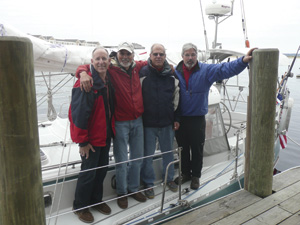 |
|
WildHorse’s intrepid crew, from left, Rick Lueders, Rick Meisner, Charles Drakos, and Bill McGraw. |
On our 10th day out of Bermuda, we fetched St. Maarten well after dark, anchoring in Simpson Bay just outside the Dutch bridge. I was worried that exhaustion had trumped euphoria as my crew, my friends, seemed slow to celebrate. We had met and overcome a frustrating, draining challenge, beating our way down to the Leewards. Hammered repeatedly by headwinds and squalls, we prevailed and here we were. So where was the music? Where was my drink?
I took out a fresh bottle of Gosling’s Black Seal rum and handed glasses all around. With homemade chili and cornbread on the stove, the recovery time was minimal — and the effects magnificent.
Good spirit prevails
After a fast trip to Bermuda without much straying from the rhumb line, WildHorse and her crew survived a nearly 10-day struggle to fetch St. Maarten. Our initial easterly course added 150-plus nm to the 857 nm from Bermuda to St. Maarten. Adding more than 30 tacks (no gybes), along with lengthy east/west runs, I estimate WildHorse traveled more than 1,200 nm to make good 857. Our velocity made good was a paltry 3.8 knots, but over the whole distance traveled, average speed was 5.25 knots (estimated). I think the biggest issue was disappointment: when your careful sailing strategy doesn’t work; when you struggle with changing forecasts; when you reach 22° N where you have every right to expect more settled weather and the easterly trades to fill in, and instead you have contrary wind and squally, nasty conditions; all produced a disturbing conflict between expectation and reality, and an unplanned contest of spirit and will.
Rick Meisner sails out of Watch Hill, R.I., and is a former corporate executive with a master’s degree in clinical psychology.

